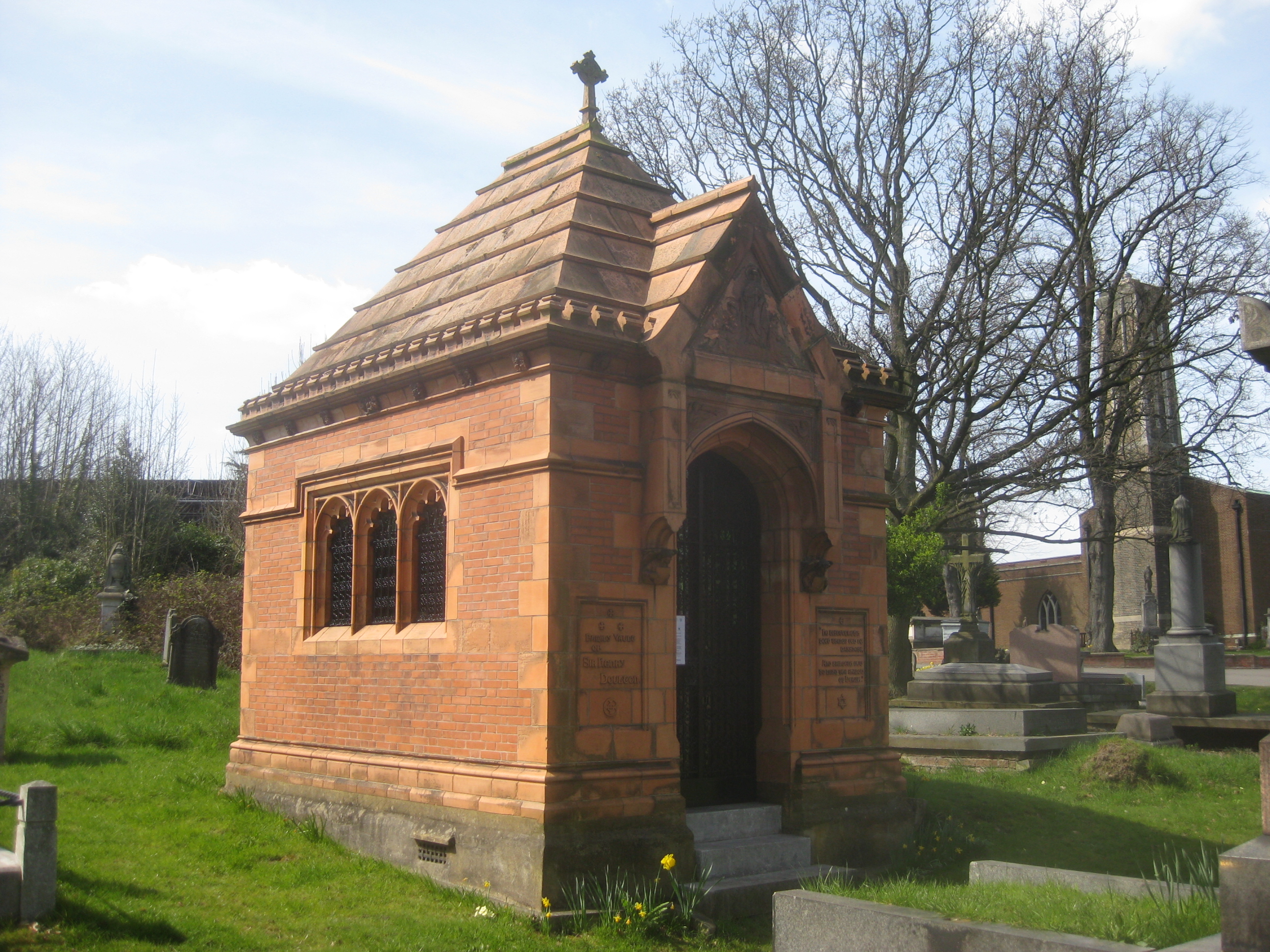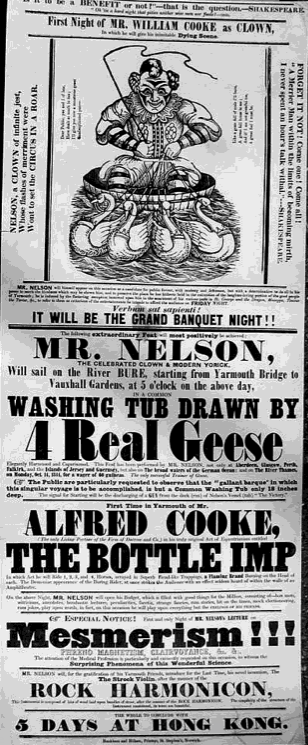|
Thomas Barry (clown)
Thomas Barry (c. 1810 – 23 March 1857) was an Irish circus clown. He worked with various circuses but was associated most with Astley's Circus. Barry was a traditional "buffoon" whiteface clown whose performances were based on physical humour. In 1844 he featured in a famous stunt whereby he appeared to be towed along the River Thames in a tub pulled by four geese. Barry left Astley's Circus in 1848 after falling-out with another clown, though he later returned, he retired permanently in 1856 after another disagreement. Whilst out of the circus Barry was landlord of the Crown Tavern in Lambeth. Early life and career Thomas Barry was born in Ireland in around 1810. He was married to Elizabeth Campbell (died 1873), an actress who performed at Sadler's Wells Theatre and in Marylebone. Barry's son, also called Thomas Barry, was born in Manchester in 1839 – he would later also perform as a circus clown. Barry joined Sam Wild's Circus in 1837 and performed in Swansea, Wales ... [...More Info...] [...Related Items...] OR: [Wikipedia] [Google] [Baidu] |
West Norwood Cemetery
West Norwood Cemetery is a rural cemetery in West Norwood in London, England. It was also known as the South Metropolitan Cemetery. One of the first private landscaped cemeteries in London, it is one of the " Magnificent Seven" cemeteries of London, and is a site of major historical, architectural and ecological interest. Its grounds are a mixture of historic monumental cemetery A cemetery, burial ground, gravesite or graveyard is a place where the remains of dead people are buried or otherwise interred. The word ''cemetery'' (from Greek , "sleeping place") implies that the land is specifically designated as a buri ... and modern cemetery#Lawn cemetery, lawn cemetery, but it also has catacombs, cremation plots and a cemetery#Columbarium wall, columbarium for cinerary ashes. The cemetery's crematorium still operates, and cremation plots are still available, but all the conventional burial plots have been allocated and hence it is closed to new burials pending further ag ... [...More Info...] [...Related Items...] OR: [Wikipedia] [Google] [Baidu] |
Richard Usher
Richard Usher (1785 – 23 September 1843) was an English clown and theatre designer. He performed for many years at Astley's Amphitheatre. Early life and career He was born in 1785. His father, the proprietor of a mechanical exhibition, travelled in the north of England and in Ireland. Richard took a share in the management of the exhibition, and inherited his father's talent in the construction of curious contrivances. With a friend he gave exhibitions in Newcastle, Manchester, Liverpool, and other towns. At Christmas 1807 he appeared at the Liverpool Amphitheatre as a clown, and was immediately successful. In 1809 he first appeared at Astley's Amphitheatre in London, and remained popular there for many years. His annual benefit was an occasion on which extraordinary performances took place both in and out of the theatre. The most remarkable of these took place in 1828, when in a washing-tub drawn by geese he sailed down the Thames from Westminster to Waterloo Bridge. He was then ... [...More Info...] [...Related Items...] OR: [Wikipedia] [Google] [Baidu] |
1857 Deaths
Events January–March * January 1 – The biggest Estonian newspaper, ''Postimees'', is established by Johann Voldemar Jannsen. * January 7 – The partly French-owned London General Omnibus Company begins operating. * January 9 – The 7.9 Fort Tejon earthquake shakes Central and Southern California, with a maximum Mercalli intensity of IX (''Violent''). * January 24 – The University of Calcutta is established in Calcutta, as the first multidisciplinary modern university in South Asia. The University of Bombay is also established in Bombay, British India, this year. * February 3 – The National Deaf Mute College (later renamed Gallaudet University) is established in Washington, D.C., becoming the first school for the advanced education of the deaf. * February 5 – The Federal Constitution of the United Mexican States is promulgated. * March – The Austrian garrison leaves Bucharest. * March 3 ** France and the United Kingdom f ... [...More Info...] [...Related Items...] OR: [Wikipedia] [Google] [Baidu] |
Drury Lane
Drury Lane is a street on the eastern boundary of the Covent Garden area of London, running between Aldwych and High Holborn. The northern part is in the borough of Camden and the southern part in the City of Westminster. Notable landmarks The street originated as an early medieval lane referred to in Latin as the ''Via de Aldwych'', which probably connected St. Giles Leper Hospital with the fields of Aldwych Close, owned by the hospital but traditionally said to have been granted to the Danes as part of a peace treaty with King Alfred the Great in Saxon times. It acquired its name from the Suffolk barrister Sir Robert Drury, who built a mansion called Drury House on the lane around 1500. After the death in 1615 of his great-great-grandson, another Robert Drury, the property passed out of the family. It became the London house of the Earl of Craven, then a public house under the sign of his reputed mistress, the Queen of Bohemia. Subsequently, the gardens and courtyards ... [...More Info...] [...Related Items...] OR: [Wikipedia] [Google] [Baidu] |
Wolverhampton
Wolverhampton () is a city, metropolitan borough and administrative centre in the West Midlands, England. The population size has increased by 5.7%, from around 249,500 in 2011 to 263,700 in 2021. People from the city are called "Wulfrunians". Historically part of Staffordshire, the city grew initially as a market town specialising in the wool trade. In the Industrial Revolution, it became a major centre for coal mining, steel production, lock making, and the manufacture of cars and motorcycles. The economy of the city is still based on engineering, including a large aerospace industry, as well as the service sector. Toponym The city is named after Wulfrun, who founded the town in 985, from the Anglo-Saxon ''Wulfrūnehēantūn'' ("Wulfrūn's high or principal enclosure or farm"). Before the Norman Conquest, the area's name appears only as variants of ''Heantune'' or ''Hamtun'', the prefix ''Wulfrun'' or similar appearing in 1070 and thereafter. Alternatively, the city ma ... [...More Info...] [...Related Items...] OR: [Wikipedia] [Google] [Baidu] |
Marie Macarte
Marie Elizabeth Macarte (1827 –20 September 1892) was an English equestrienne and circus performer who found success in Britain and the United States in the 1840s to 1860s. Early life and career Born in her mother's home town of Leigh-on-Sea in Essex in 1827 as Marie Elizabeth Ginnett, she was the daughter of Ann ''née'' Partridge (1803–1877) and the circus performer Jean Pierre Ginnett (1798-1861). Her older brother was John Frederick Ginnett (1825–1892), who later was the proprietor of Ginnett's Circus. A distant relative was the lion-tamer Thomas Macarte who was killed in the ring in 1872. Marie Ginnett was a pupil of Andrew Ducrow and started performing as Miss Ginnett when she was about 3 years old. In 1841 she married Michael 'John' Macarthy, an equestrian artiste performing with her father and later a vaulter, tumbler and acrobat who had performed at Astley's Royal Amphitheatre in London and who was a member of the Macarte dynasty of acrobats and circus ... [...More Info...] [...Related Items...] OR: [Wikipedia] [Google] [Baidu] |
William Henry Harvey
William Henry Harvey, FRS FLS (5 February 1811 – 15 May 1866) was an Irish botanist and phycologist who specialised in algae. Biography Harvey was born at Summerville near Limerick, Ireland, in 1811, the youngest of 11 children. His father Joseph Massey Harvey, was a Quaker and prominent merchant. William started his education at Ballitore School in County Kildare and by the age of 15 had already established algae as his over-riding interest.Papenfuss, G.F. 1976. pp.21–46. Landmarks in Pacific North American Marine Phycology. ''in'' Abbott, I.A. and Hollenberg, G.J. 1976. ''Marine Algae of California''. Stanford University Press, California. After leaving school he joined the family business. Harvey was an authority on algae and bryophytes ( mosses), and author of ''A Manual of the British Algae'' (1841), ''Phycologia Britannica'' (4 vols., 1846–51), ''Nereis Boreali-Americana.'' (3 parts 1852–85) and '' Phycologia Australica'' (5 vol., 1858–63). He spent several y ... [...More Info...] [...Related Items...] OR: [Wikipedia] [Google] [Baidu] |
Windsor, Berkshire
Windsor is a historic market town and unparished area in the Royal Borough of Windsor and Maidenhead in Berkshire, England. It is the site of Windsor Castle, one of the official residences of the British monarch. The town is situated west of Charing Cross, central London, southeast of Maidenhead, and east of the county town of Reading. It is immediately south of the River Thames, which forms its boundary with its smaller, ancient twin town of Eton. The village of Old Windsor, just over to the south, predates what is now called Windsor by around 300 years; in the past Windsor was formally referred to as New Windsor to distinguish the two. Etymology ''Windlesora'' is first mentioned in the ''Anglo-Saxon Chronicle.'' (The settlement had an earlier name but this is unknown.) The name originates from old English ''Windles-ore'' or ''winch by the riverside''.South S.R., ''The Book of Windsor'', Barracuda Books, 1977. By 1110, meetings of the Great Council, which had previousl ... [...More Info...] [...Related Items...] OR: [Wikipedia] [Google] [Baidu] |
Shakespearean Fool
The Shakespearean fool is a recurring character type in the works of William Shakespeare. Shakespearean fools are usually clever peasants or commoners that use their wits to outdo people of higher social standing. In this sense, they are very similar to the real fools, and jesters of the time, but their characteristics are greatly heightened for theatrical effect. The "groundlings" (theatre-goers who were too poor to pay for seats and thus stood on the 'ground' in the front by the stage) that frequented the Globe Theatre were more likely to be drawn to these Shakespearean fools. However they were also favoured by the nobility. Most notably, Queen Elizabeth I was a great admirer of the popular actor who portrayed fools, Richard Tarlton. For Shakespeare himself, however, actor Robert Armin may have proved vital to the cultivation of the fool character in his many plays. The Fools Fools have entertained a varied public from Roman through Medieval times. The fool perhaps reached i ... [...More Info...] [...Related Items...] OR: [Wikipedia] [Google] [Baidu] |
Yarmouth Suspension Bridge
Yarmouth suspension bridge spanned the River Bure at Great Yarmouth, Norfolk from 1829 until its collapse in 1845. The bridge was widened in 1832, which had not been anticipated by the original design. On 2 May 1845, the bridge collapsed under load from a crowd who had gathered to watch a circus stunt on the river. Some 79 people, mainly children, were killed. An investigation found fault with the design and quality of the bridge. A modern-day memorial marks the site of the disaster. Bridge An Act of Parliament was passed in 1827 for the construction of a bridge over the River Bure at Great Yarmouth. The Cory family paid for the bridge to replace a ferry and provide easier access from the town to marshland, the Vauxhall Pleasure Gardens, and a bowling green owned by the family. A toll on those crossing would recoup the investment. The architect for the bridge was Joseph John Scoles of London. He designed a suspension bridge with two towers and a clear span of . The span was ... [...More Info...] [...Related Items...] OR: [Wikipedia] [Google] [Baidu] |






